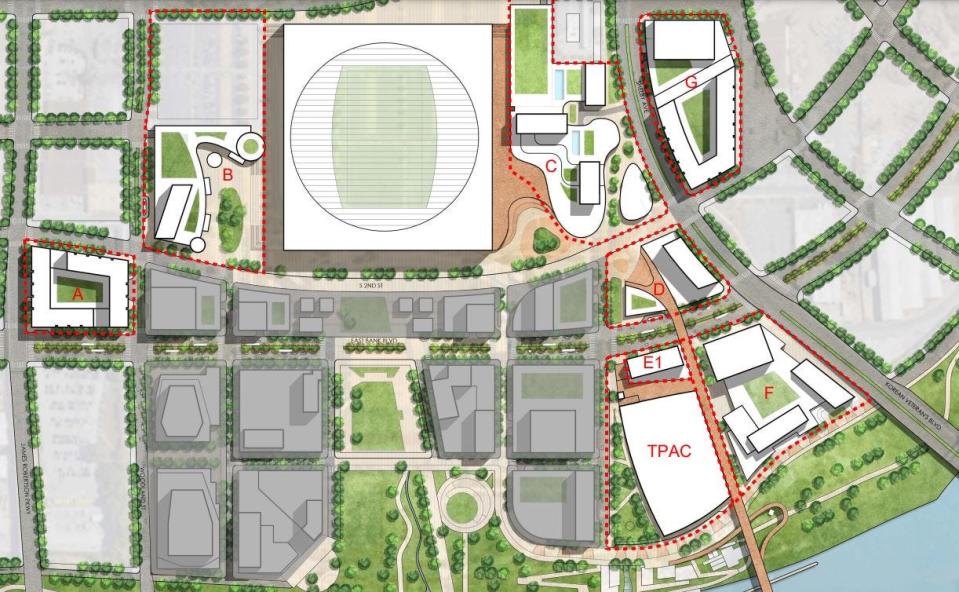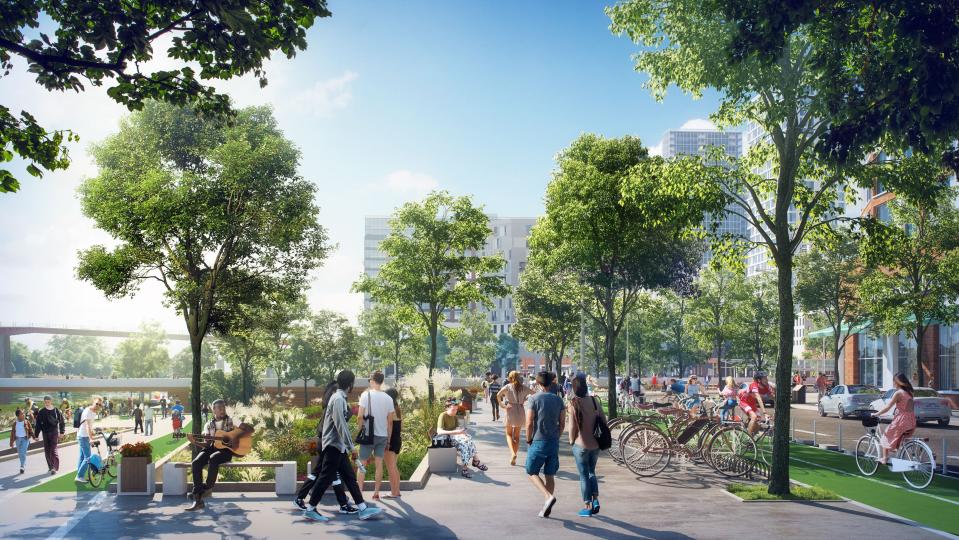Nashville's East Bank: What's on the table for new Tennessee Performing Arts Center
Plans to relocate the Tennessee Performing Arts Center to Nashville's redeveloping East Bank are solidifying with Metro Council poised to consider a preliminary agreement with the center.
The council will review a nonbinding memorandum of understanding providing a glimpse at what a new TPAC could look like on March 7. The document also lays out TPAC's cost and infrastructure responsibilities in exchange for a lease on Metro-owned riverside land. Future binding agreements will require additional Metro Council approval.
Among the list of public amenities to be financed by the center is an extension of the John Seigenthaler Pedestrian Bridge to provide continuous downtown-East Bank access to pedestrians and cyclists.
TPAC is a nonprofit that partners with the state to provide educational experiences for school children, and affordable performance spaces for the Nashville ballet, opera and repertory theater. It also hosts touring Broadway productions and other events. The organization has called the state-owned James K. Polk Cultural Center home since 1980, but began exploring other options as the state contemplated redeveloping the downtown building, which is in need of upwards of $100 million in repairs.
What would a new TPAC look like?

The new performing arts center would be located on a 3.3-acre parcel of Metro-owned land near the outlet of the pedestrian bridge on the east bank of the Cumberland River. The "multi-use community, performance and education space" would have several facets:
A 2,600-seat multipurpose theater
A 1,200-seat dance and opera hall
A 500-seat flexible venue
Four rehearsal studios (to be used for rehearsals, classroom space and for community events)
TPAC administrative offices
At least one publicly accessible exterior plaza providing public access to and from the riverfront
TPAC would design and build an extension of the John Seigenthaler Pedestrian Bridge compatible with retail and cultural activities. In a separate proposed development agreement between Metro and developer The Fallon Company for the city's initial 30-acre development area, Fallon would be responsible for building another portion of the pedestrian bridge that extends to South Second Street, where pedestrians could enter a plaza adjoining the new Nissan Stadium.
The Center would set a 25% goal for minority- and women-owned business participation, and make "commercially reasonable efforts" to use local goods, vendors and labor in the center's operation.

TPAC would also cover costs for:
Street improvements along Waterside Drive and Victory Avenue
Storm water management improvements
Utilities not already being installed as part of Metro's agreements with the Tennessee Titans or The Fallon Company
All designs require approval from the Metro Planning Commission, and Metro has authority to monitor construction.
Who pays for this?
TPAC would have to prove it can cover the costs of the project (determined through a guaranteed maximum price contract) and any potential overruns before Metro would allow construction to begin.
State lawmakers approved a $200 million grant to help pay for the center's relocation from its current downtown seat, but TPAC will need to put up a 20% match for the state to release those funds. TPAC would source another $100 million minimum in pledges from donors, and could seek private construction financing.
Metro would enter into a 35-year lease with TPAC with rent set at $100 per year. TPAC would have the option of two 30-year renewal terms, with rent set at 25% of the market value at that time, with annual increases.
Under the proposed lease, TPAC would claim all revenue from operations in the center and on-site, advertising included. The center would foot the bill for operating and maintenance costs, utilities and insurance, in addition to agreeing to contribute toward operation and maintenance of the pedestrian bridge.
Metro could host up to three civic events at the center per year and would reimburse TPAC for operating costs for those events.
TPAC would shoulder the responsibility for securing parking for events at the center.
What is the timeline?
Metro Council will consider the nonbinding resolution (which requires only one vote to pass) on March 7. The document states it is "solely for the purpose of facilitating ongoing discussions."
Should Metro and TPAC later agree to formalize the terms laid out in the resolution, TPAC will have until Sept. 30, 2025, to meet the following milestones:
TPAC secures the entirety of the state's $200 million contribution and donor contributions
TPAC delivers a concept design and receives Metro Planning approval
TPAC provides a preliminary budget to Metro
TPAC provides proof of sufficient private financing
Before beginning construction, TPAC would need to obtain Metro approval for the final design and confirm its ability to fund the full project. TPAC would need to begin construction by Sept. 30, 2027.
This article originally appeared on Nashville Tennessean: Nashville East Bank: TPAC move could bring studios, opera hall, plaza

